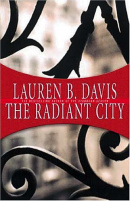 In her beautiful new novel, “The Radiant City,” Canadian writer Lauren B. Davis evokes a Paris that is decidedly on the edge, a city in which everyone has come from somewhere else and is trying desperately to lose themselves.
In her beautiful new novel, “The Radiant City,” Canadian writer Lauren B. Davis evokes a Paris that is decidedly on the edge, a city in which everyone has come from somewhere else and is trying desperately to lose themselves.
The story centers around Matthew Bowles, a traumatized war correspondent whose last assignment in Hebron left him riddled with bullet holes and emotionally paralyzed. After being discharged from the hospital, he packs his bags and moves to Paris where he meets up with Jack Saddler, an ex-mercenary, and the Ferhat family, Lebanese immigrants who have come to Paris to escape a war-torn past. But, why Paris?
“Paris is a unique city in the way it supports illusion, I think,” says Davis. “People come to Paris to work out something, to try a dream that may very well have failed at home. They believe they can either forget themselves, or find themselves… it was these extremes I wanted to explore, margins where cultures and beliefs collide. And because Paris is a place that attracts both those wanting anonymity and those wanting to escape something, I thought it would be a perfect setting for Matthew, who is seeking precisely that. That’s the thing about Paris: you may not be changed in the way you dreamed of, but you will certainly be altered.”
It is Matthew’s journey from a state of total emotional paralysis to some kind of self-understanding that drives the narrative, but the novel’s scope is much wider; as “The Radiant City” progresses, Matthew’s becomes just one among a number of outsider stories that together make up a cohesive, beautiful, and stunningly realistic portrait of life on the fringes of the City of Light, far away from the haute couture and tourist destinations that fiction about Paris is known for. In “The Radiant City,” the Louvre is as far away – or even further – than the war zones of Rwanda, Bosnia, and Hebron.
Unsurprisingly, one of the central metaphors of “The Radiant City” is the multifaceted way in which light operates – by providing comfort while at the same time revealing things that are perhaps better left unseen. In the novel, Paris is the earthly embodiment of light, an illuminated city full of contradictions and a million angles and oppositions that slowly uncover one another. “What better environment to explore the mind of someone already psychologically frayed, someone like Matthew, who is nearly skinless he’s so raw?” says Davis.
While the book certainly delves deeply into the trauma of war – and Davis should be commended on her excellent research on the subject – “The Radiant City” is at the heart a novel about recapturing a sense of wonder and belonging. At times it reads like an extended meditation on the value of existence, set in the midst of a city within which, just by walking around, one can see the extremes of human nature. As Davis puts it, “a city that is both beautiful and brutal – what better setting for a novel about someone who has suffered disillusionment as profoundly as that which Matthew experienced?” “The Radiant City” answers this question with grace, stunning realism, and true insight into what keeps a person – and a city – alive.

